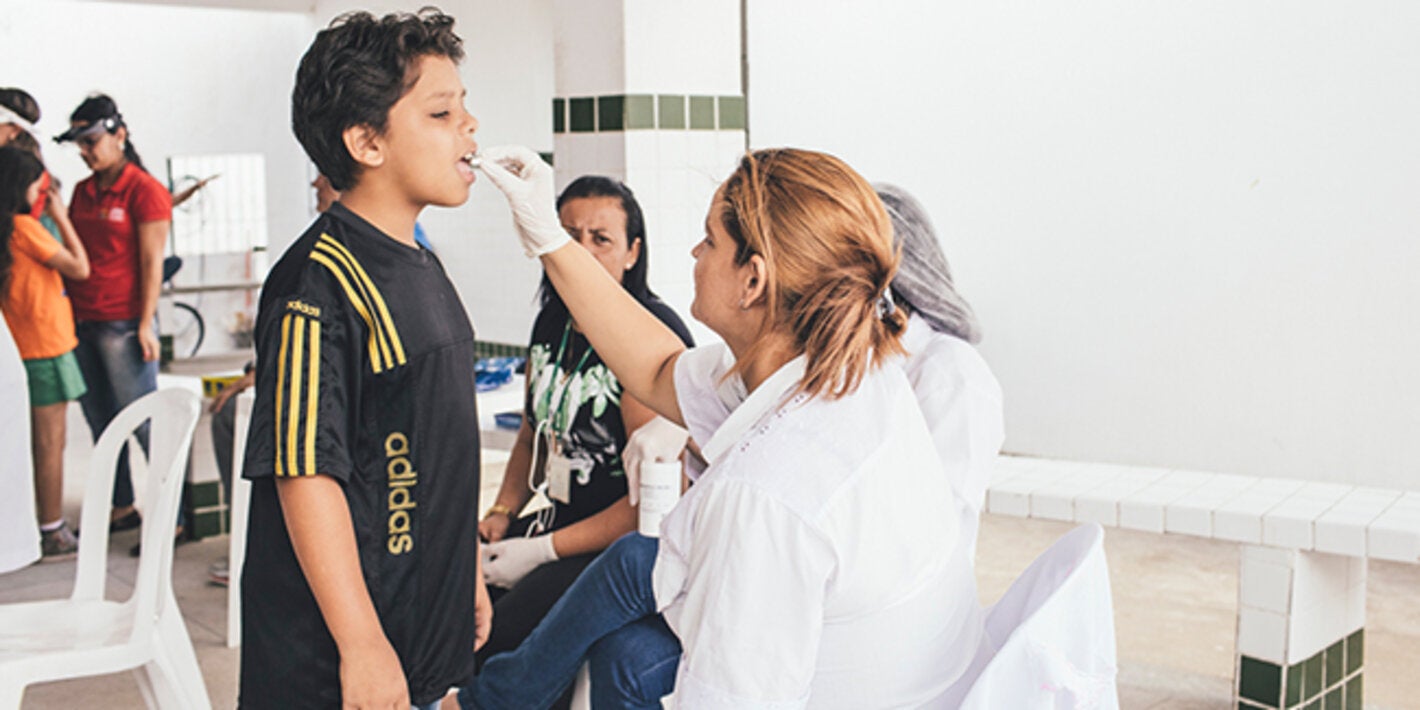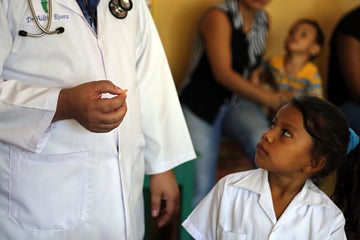
19 February (PAHO/WHO) — The World Health Organization (WHO) is urging affected countries to scale up their investments in the fight against neglected tropical diseases, to improve the health and well-being of more than 1.5 billion people. This investment would represent as little as 0.1% of current domestic expenditure on health in affected low- and middle-income countries for the period 2015-2030.
En las Américas, más de 100 millones de personas padecen alguna enfermedad infecciosa desatendida, como malaria, Chagas, lepra y la geohelmintiasis
19 de febrero de 2015 (OPS/OMS)— La Organización Mundial de la Salud (OMS) instó a los países afectados a aumentar su inversión financiera para enfrentar las enfermedades tropicales desatendidas con el fin de mejorar la salud y el bienestar de más de 1,5 mil millones de personas en el mundo. Esta inversión representaría el 0,1% del gasto doméstico corriente en salud en los países de ingresos bajos y medianos durante 2015-2030.
 In the Americas, more than 100 million people suffer from one or more neglected infectious diseases, including Chagas, leprosy, malaria, blinding trachoma, and soil-transmitted helminths. These infections cause blindness, disfigurement, disabilities and even death, especially among people living in poverty.
In the Americas, more than 100 million people suffer from one or more neglected infectious diseases, including Chagas, leprosy, malaria, blinding trachoma, and soil-transmitted helminths. These infections cause blindness, disfigurement, disabilities and even death, especially among people living in poverty.
The new WHO report Investing to Overcome the Impact of Neglected Tropical Diseases outlines an investment case and essential interventions to combat these diseases. In the Americas, the Pan American Health Organization (PAHO/WHO) is providing technical cooperation to its member countries to control and advance toward the elimination of several of these same diseases.
"These diseases can be eliminated, and many of them can be addressed through low-cost, integrated actions," said Marcos Espinal, Director of PAHO/WHO's Department of Communicable Diseases and Health Analysis.
A total of 10 diseases have been targeted for elimination in the Americas between 2015 and 2020: lymphatic filariasis, onchocerciasis, blinding trachoma, Chagas disease, malaria, leprosy, congenital syphilis, neonatal tetanus, rabies transmitted by dogs, and plague. Two others—soil-transmitted helminths and schistosomiasis—are priorities for bringing under control. These goals were set by PAHO/WHO's Directing Council in 2009 in alignment with WHO's 2015-2020 roadmap for tackling neglected tropical diseases.
"Sustained commitment and investment by governments, as well as the support of international agencies and other partners, continue to be key for controlling and eliminating these diseases," said Luis Gerardo Castellanos, PAHO/WHO senior advisor on prevention and control of infectious diseases.
Progress in the Americas
- Onchocerciasis has been eliminated in Colombia and Ecuador. Guatemala and Mexico are on track to eliminate transmission, leaving just one border area between Brazil and Venezuela with ongoing transmission of the disease.
- Leprosy has been eliminated at the national level in 34 of the region's 35 countries. New Cases declined 37% between 2003 and 2013.
- More than half of the region's countries with endemic Chagas disease have eliminated transmission by the disease's principal domestic insect vector, and 20 of 21 endemic countries have implemented universal blood screening for Chagas.
- • Antigua and Barbuda, the Dominican Republic, Guadalupe, Martinique, Montserrat, and Puerto Rico may have eliminated transmission of schistosomiasis, and St. Lucia and Suriname are close to elimination.
- Costa Rica, Suriname, and Trinidad and Tobago were struck from the list of countries with endemic lymphatic filariasis in 2011. More than 7 million people were treated for this disease in 2013, most of them in Haiti.
- • More than 6 million preschool children and nearly 23 million school-age children in 12 countries of the Americas were given deworming treatment against soil-transmitted helminthes in 2013.
- Deaths from malaria declined by 72% between 2000 and 2012 in the Americas, and the number of cases declined 60%.
- Fifteen countries in the region have achieved the goal of no more than one in 2,000 infants being born with congenital syphilis.
- Human rabies transmitted by dogs is now limited to only a few areas in the Americas.
- Mexico is close to eliminating blinding trachoma.
- Of the millions of people at risk of infectious neglected diseases in Latin America and the Caribbean, many are receiving safe and effective treatment through mass administration of medications for five diseases: lymphatic filariasis, onchocerciasis, blinding trachoma, soil-transmitted helminths, and schistosomiasis. These medications are donated, while others are being procured through PAHO/WHO's Strategic Fund or through the Global Fund to Fight AIDS, Tuberculosis and Malaria.
Most countries in the Americas have national plans and programs to fight neglected tropical diseases, and PAHO/WHO is supporting their efforts to implement them.
###
PAHO, founded in 1902, is the oldest international public health organization in the world. It works with its member countries to improve the health and the quality of life of the people of the Americas. It also serves as the Regional Office for the Americas of WHO.
Links:
- Investing to Overcome the Impact of Neglected Tropical Diseases
- Neglected Infectious Diseases
- Infographic: Neglected Infectious Diseases in the Americas
- Map: Situation and Distribution of Neglected Infectious Diseases in the Americas
- 10 vector-borne diseases that put the population of the Americas at risk
- Resolution on Elimination of Neglected Diseases and Other Poverty-Related Infections (CD49.R19)
- London Declaration on Neglected Tropical Diseases
- Second WHO [global] report on neglected tropical diseases



